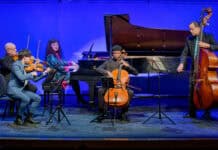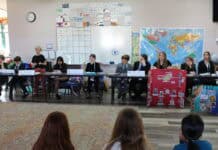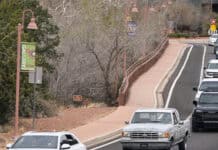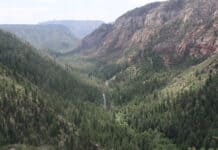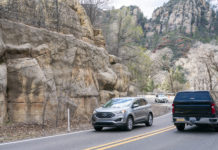Protestors who oppose adding streetlights on Hwy. 89A turn up the heat next week when they pitch a compromise to the Sedona City Council and host a talk by International Dark-Sky Association co-founder David Crawford.
By Greg Ruland
Larson Newspapers
Protestors who oppose adding streetlights on Hwy. 89A turn up the heat next week when they pitch a compromise to the Sedona City Council and host a talk by International Dark-Sky Association co-founder David Crawford.
The Pedestrian Safety Advisory Group, a committee of concerned residents organized by City Manager Eric Levitt, meets at 9 a.m. Wednesday, Nov. 7.
The committee has invited Arizona Department of Transportation representatives and members of City Council to attend.
ADOT officials are expected to help flesh out ADOT’s plan to erect 76 streetlights in West Sedona.
Many on the residents’ committee reject ADOT’s proposal for 76 streetlights in favor of a compromise that would install one traffic light at Andante Drive, lower the 40 mph speed limit on Hwy. 89A and increase the number of signs in West Sedona directing pedestrians and drivers to be more careful.
ADOT proposed its plan for streetlights after three pedestrians in the last two years were struck and killed by cars when motorists were unable to see them trying to cross the highway after dark.
Two of the fatalities resulted from collisions near Andante Drive.
"We have a really defining issue now in Sedona," said Barbara Litrell, president of Keep Sedona Beautiful, a local organization of conservationists.
Litrell and many of her supporters see the issue in black and white. For KSB, the question Sedona must decide is "lights or no lights."
A recent poll of KSB’s 300 members received 30 responses. All but one opposed streetlights of any kind, Litrell said.
"We’re hoping for leadership and direction from the council on this issue," she said. "My impression from ADOT [is] they [are] willing to do what the city asks them to do."
As a matter of law, state highways like Hwy. 89A are exempt from city and county ordinances that restrict the type or number of streetlights ADOT decides to install, according to Bob Carabell, a retired attorney and KSB’s vice president.
Carabell helped write light pollution control laws now in force in Sedona and Yavapai County.
Although ADOT is not required to comply with local laws, "experts will tell you that ADOT tries to comply as best it can," he said.
In Flagstaff, for example, ADOT agreed to install low-pressure sodium lights along I-17 and elsewhere, but only after the city agreed to pay for and maintain them.
In 2001, Flagstaff was the first city declared an International Dark-Sky City by Crawford’s organization.
Carabell said ADOT’s plan for 76 lights could comply with light pollution control laws in Sedona if low-pressure sodium lights are used.
Unlike high-pressure sodium lights, ADOT’s preferred choice, low-pressure sodium lights eliminate most of the light reflected back into the sky from the street.
I-17 travellers know low-sodium pressure lights in Flagstaff "make it look like you’re driving through a tunnel," Carabell said, because the system confines light to areas where it is needed.
Though hoods and shields on standard streetlights help by directing light down to the ground, streetlights that don’t operate on low-pressure sodium reflect at least 15 percent of the light they give off back into the sky, Carabell said.
An amateur astronomer since the time he constructed his own telescope in eighth grade, Carabell said he grew concerned about the issue when "the stars in the skies disappeared" from view in the Ohio city where he practiced law.
Sedona is a great place to look at the stars, Carabell said, and he and most KSB members want to make sure night skies remain pollution-free in Sedona.
The night after the council work session, KSB hosts Crawford, former head of technology transfers at the National Optical Observatories, in Tucson, for a presentation at the Sedona Public Library.
As executive director of the International Dark-Sky Association in Tucson, Crawford told The New Yorker magazine in its Aug. 20 edition that his group is "on a mission to change the world at night."
"We’re sort of a nighttime Sierra Club," Crawford stated in the article by David Owen.


